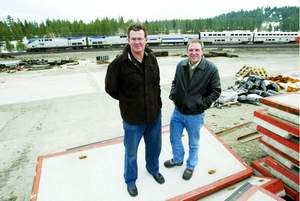On the right track
OAKLAND TRIBUNE
by By David Bunker
March 22, 2005
Looking beyond scrap heaps, stacks of dusty pallets and lengths of rusting rail scattered around the downtown Truckee railyard, Rick Holliday sees a blank canvas.
Under a cold, battleship-gray sky last week, Holliday swept his outstretched arm in arc in front of him, and in broad strokes painted a picture for the 21 acres of history-filled, but now desolate, land he owns in the heart of Truckee.
In the eyes of the developer who has transformed a number of long-neglected Bay Area landmarks into upscale housing, the railroad detritus, contamination and flooding problems of the railyard site are dwarfed by the huge upside of the property — a large tract of flat land next to a historic downtown.
“The thing that catches any developer’s eye is the size,” Holliday said.
Picturing a pedestrian-oriented town center on the deserted railroad property abutting downtown Truckee takes imagination. But imagination is exactly what has gotten Truckee’s railyard to the point it is now. A little over a year after Holliday Development bought the property from Union Pacific Railroad, planners are saying the project could become one of the most innovative in the Sierra Nevada.
WHAT DOES THE DOWNTOWN SPECIFIC PLAN CALL FOR?
The Downtown Specific Plan, the town’s overall vision for its downtown, lays out some guidelines for what the railyard development should contain. In the plan the railyard is identified as the “main growth area.”
Multi-family residential — 100 units
Commercial — 125,000 square feet
Industrial — 5,000 square feet
Office — 30,000 square feet
Lodging — 250 units
Public, Institutional — 75,000 square feet
DEVELOPMENT DILEMMAS
But along with the incredible opportunities, the railyard development presents several hard-to-resolve dilemmas. The largest of these is its side-by-side coexistence with downtown.
Trying to balance the design and intensity of development so it complements rather than competes with Truckee’s historic downtown will be crucial to the developments success, planners say.
“The problem there is you have a downtown that was built over 125 years … and then you have something that will be built over 20 years,” said Truckee Community Development Director Tony Lashbrook.
To solve this problem, the town has developed nine character areas within the railyard site that emulate the design and character of sections of downtown. These areas will create the same varied feel visitors experience in a walk through downtown.
The areas closest to downtown, which will be accessed by an extension of Church Street, Donner Pass Road or both, will likely borrow from the designs of the downtown commercial districts, Brickelltown and Commercial Row.
Further inside the project, building types will be guided by whether they border Trout Creek to the north, the new area’s main street in the center, or the railroad tracks to the south.
Specific ideas for the railyard development include various types of housing, shops, a movie theater, ample parking and a public park. Trout Creek and the railroad will be integral in shaping the character of the town.
For Holliday, who owns a second home in Truckee, the emphasis will be on creating a “there” for downtown.
“(Truckee) has a great town and a great energy, but they don’t have a great space that is theirs,” he said.
Making the railyard project one that completes the downtown area, while not cutting itself off as a separate entity, is another challenge.
“That is the $64,000 question,” Holliday said. “How do you create an environment over here that respects (downtown)?”
If the project is done right, said Stefanie Olivieri, owner of several downtown shops, the fears that the railyard will compete with Commercial Row are unfounded.
“I see it as an important piece to the puzzle for downtown,” Olivieri said. “I don’t think it will be a competitor. I think that it will be part of the whole if it is done right.”
Another problem, which is close to being resolved, is the relocation of the “balloon track.” Holliday Development is working with Union Pacific Railroad to move the circular railroad spur, occasionally used by rail-clearing snow plows to turn around, to the eastern edge of the site. That would allow one contiguous development abutting downtown, rather than two parcels split by the tracks.
A UNIQUE PARTNERSHIP
Part of the project’s unconventionality is that Holliday Development and the Town of Truckee are working hand in hand to come up with a plan to develop the site. That public-private partnership is unheard of in Truckee and throughout the region, said Tony Lashbrook, Truckee community development director .
“We’re asking the developer to design the project in concert with the town,” said Lashbrook. “It’s pretty unique.”
The key link in that partnership is Darin Dinsmore, the go-between planner for Holliday Development and the Town of Truckee over the last year. After living in Truckee for several years, Dinsmore knows the challenges facing Commercial Row, such a parking.
“If you don’t have a parking problem, you don’t have successful downtown,” he said.
Dinsmore has spent time analyzing downtown development projects throughout the western United States to come up with ideas for the railyard. Along with architectural ideas, Dinsmore has come away with a sense of what the railyard presents.
“This,” Dinsmore said while pointing to Mt. Rose looming in one direction and the Sierra crest in the other, “is the biggest opportunity of any mountain town in the west.”
HISTORICAL TIMELINE OF RAILYARD AREA
1868 — The western end of railyard is created. It is used as a staging point to lay the east along the Truckee River. A wooden roundhouse is built.
1878 — A larger roundhouse built.
1887 — The first icehouse is built to store and transfer ice to cooler cars.
1901 — The first “balloon track” was built to allow snow plows to turn around.
1909 — The balloon track was modified to handle heavier locomotives.
1939 — The Roundhouse roof is removed.
1955 — The Roundhouse walls are removed.
1990 — Truckee’s lumber mill, which inhabited the site, closes.
* compiled by Gordon Richards, Truckee Donner Historical Society



